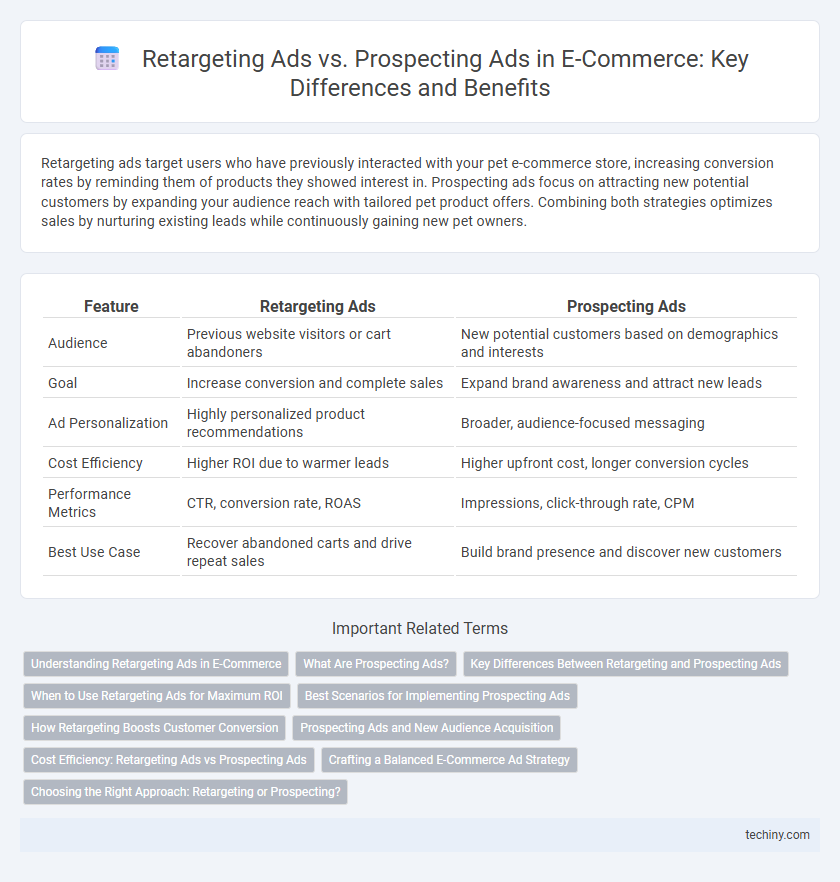Retargeting ads target users who have previously interacted with your pet e-commerce store, increasing conversion rates by reminding them of products they showed interest in. Prospecting ads focus on attracting new potential customers by expanding your audience reach with tailored pet product offers. Combining both strategies optimizes sales by nurturing existing leads while continuously gaining new pet owners.
Table of Comparison
| Feature | Retargeting Ads | Prospecting Ads |
|---|---|---|
| Audience | Previous website visitors or cart abandoners | New potential customers based on demographics and interests |
| Goal | Increase conversion and complete sales | Expand brand awareness and attract new leads |
| Ad Personalization | Highly personalized product recommendations | Broader, audience-focused messaging |
| Cost Efficiency | Higher ROI due to warmer leads | Higher upfront cost, longer conversion cycles |
| Performance Metrics | CTR, conversion rate, ROAS | Impressions, click-through rate, CPM |
| Best Use Case | Recover abandoned carts and drive repeat sales | Build brand presence and discover new customers |
Understanding Retargeting Ads in E-Commerce
Retargeting ads in e-commerce focus on engaging users who have previously interacted with a brand's website or products, increasing conversion rates by targeting warm leads. These ads use data like browsing history, cart abandonment, and past purchases to deliver personalized content that drives users back to complete transactions. Leveraging retargeting strategies typically results in higher ROI compared to prospecting ads, which aim to attract new customers without prior engagement.
What Are Prospecting Ads?
Prospecting ads target potential customers who have not yet interacted with a brand, aiming to generate awareness and attract new audiences. These ads use demographic, interest, and behavior data to reach users likely to be interested in the products or services offered. By expanding the customer base, prospecting ads play a crucial role in driving e-commerce growth and increasing sales opportunities.
Key Differences Between Retargeting and Prospecting Ads
Retargeting ads target users who have previously interacted with a brand, leveraging their prior engagement to increase conversion rates through personalized offers and reminders. Prospecting ads aim to attract new potential customers by using broad audience targeting and interest-based criteria to expand brand awareness. The key difference lies in retargeting's focus on re-engaging warm leads, while prospecting seeks to generate initial interest among cold audiences.
When to Use Retargeting Ads for Maximum ROI
Retargeting ads deliver maximum ROI when targeting users who have already interacted with your e-commerce site by abandoning carts or browsing product pages without purchasing. Utilizing dynamic retargeting campaigns that show personalized product recommendations based on prior user behavior significantly increases conversion rates. Implement these ads during the consideration phase to re-engage warm leads and push them toward completing transactions efficiently.
Best Scenarios for Implementing Prospecting Ads
Prospecting ads perform best when targeting new customer segments with high purchase intent, leveraging detailed demographic and behavioral data to maximize reach. E-commerce brands benefit from implementing prospecting ads during product launches or seasonal campaigns to attract untapped audiences and increase brand awareness. Utilizing lookalike audiences on platforms like Facebook or Google enhances the effectiveness of prospecting ads by expanding potential customer pools with similar traits to existing buyers.
How Retargeting Boosts Customer Conversion
Retargeting ads boost customer conversion by targeting users who have previously engaged with a website or added products to their cart but did not complete a purchase, increasing the likelihood of closing sales. These ads leverage personalized content and dynamic product recommendations based on past browsing behavior, enhancing relevance and driving users back to complete transactions. Compared to prospecting ads, which focus on acquiring new customers, retargeting focuses on high-intent audiences, resulting in higher conversion rates and improved return on ad spend (ROAS).
Prospecting Ads and New Audience Acquisition
Prospecting ads in e-commerce target new audiences by leveraging data-driven strategies such as lookalike audiences and interest-based targeting to expand brand reach beyond existing customers. These ads optimize customer acquisition cost (CAC) by identifying potential buyers who demonstrate behaviors similar to high-value customers. Effective prospecting increases conversion rates and drives scalable growth by feeding the sales funnel with fresh, qualified leads.
Cost Efficiency: Retargeting Ads vs Prospecting Ads
Retargeting ads typically deliver higher cost efficiency by targeting users who have already shown interest, resulting in lower cost per acquisition (CPA) compared to prospecting ads. Prospecting ads require broader audience reach and often incur higher costs due to less targeted impressions and lower initial engagement rates. E-commerce brands benefit from allocating budget toward retargeting campaigns to maximize return on ad spend (ROAS) while using prospecting ads strategically for audience expansion.
Crafting a Balanced E-Commerce Ad Strategy
Retargeting ads target users who have previously interacted with your e-commerce store, driving higher conversion rates by reminding interested shoppers of abandoned carts or viewed products. Prospecting ads focus on acquiring new customers by targeting audience segments likely to be interested in your products based on demographics, behaviors, and interests. A balanced e-commerce ad strategy combines prospecting to expand reach and retargeting to maximize conversion efficiency, optimizing ad spend and boosting overall return on investment (ROI).
Choosing the Right Approach: Retargeting or Prospecting?
Retargeting ads target users who have previously interacted with your e-commerce store, increasing conversion rates by focusing on warm leads familiar with your brand, while prospecting ads aim to attract new potential customers by broadening your audience reach through interest and demographic targeting. Choosing the right approach depends on your campaign goals, budget, and sales funnel stage, with retargeting delivering higher ROIs for immediate sales and prospecting driving long-term growth by expanding your customer base. Combining both strategies creates a balanced marketing funnel, leveraging prospecting ads for acquisition and retargeting ads for conversion optimization.
Retargeting Ads vs Prospecting Ads Infographic

 techiny.com
techiny.com